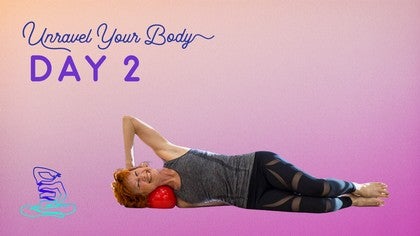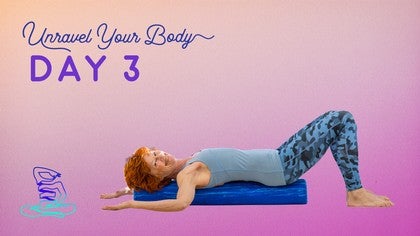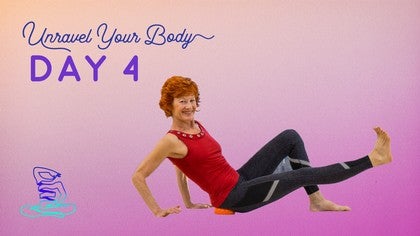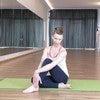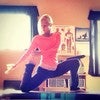Description
About This Video
Transcript
Read Full Transcript
Welcome today to have the challenge and today we're going to deal with the lower back and the upper back, the whole spinal column actually up all the way up into the neck to unravel it. The journey will be with a big ball and just very superficially we run up the sun right side of the spine, so you're going into the muscles that are right, the erector spinae rolling up. We will be widening the ribs a little bit, coming up to the side of the neck and lengthening the muscles there and then coming to the side, pressing the trapezius down and elongating the neck over that. That just so you know, we'll do right side, left side. Then we run up the center of the spine, so we'll start with a pretest just to find out what your body feels like before you do this work.
I always like to ask people just for a minute to lie on their backs and feel when the knees are bent, how much of their back is on the mat without forcing anything. You don't want to try and push anything. It'll be technical or your shoulders up by your shoulders down is one side of your rib cage touching more than the other. Then you do the same thing with the legs straight and they will most definitely be a shift in the spine. Just notice how does your body feel?
How much of your body is actually touching the mat in a very natural way because it will probably shift by the time we're done with this little routine. Another pretest will be the roll up. I'm going to take the ball just because it's hanging out here where I'm just peeling off the mat, checking to see how easy or challenging it is for me to roll. Do I have a lot of articulation or is my back feeling stiff and tight and then the other one will be rolling up. How much can I peel off the mat for spine stretch forward so my feet are all maybe 40 degrees or so.
Can I sit up straight and then how much can I lift? Widen the back in scoop. So what does my back feel like? Do you feel that one side of the spine is different than the other? Is part of the ribs different? Just kind of little tasks before we start the actual unraveling process.
Starting by, um, sitting up. You want to take the ball and pray, place it as close up to the side of your spine on the right side, kind of cradling the side of the sacrum and the tailbone. If you can, bending the knees a little bit and draping down. Now there's an imbalance that you'll deal with with your pelvis. You try to keep yourself as even as possible. You won't be even, but the pressure is into the ball. I'm also pulling my stomach in because the goal is to soften the bones and the tissue. Now I'm lifting my pelvis a little bit and then curling the tail down.
But I'm keeping pressure into the ball. I feel that all the tissue of my spine now, my spine, I'm sorry, the pelvis, even in the, there's pressure into the ball all the way up to the top of the pelvis. So just curling up and curling. Now the third time, here I am, I'm up, I'm rolling down. I'm ironing out the side of the right side of my spine, the muscles on that side, and then again, I'm curling my pelvis down, lifting up and pulling my stomach to the spine, the spine to the ball. So I'm putting pressure into the ball and rolling down.
And one more time. Lifting up this way and rolling a little bit further. So now actually into the waist and the sides of my base, my lower ribs and lowering down. Sometimes people find it strenuous on the neck. Maybe they hold the neck a little bit. So lifting up, lowering down. And this is where we start to add another move.
I'm just leaning back into the ball. I'm not inflating and relaxing. I'm actually holding my shape, but I'm putting pressure into the ribs and into the bony structure and the tissue. Curl the hips up, roll down a little bit, lean back a little bit without inflating the ribs. I'm actually keeping my alignment, but working into the muscles structure, moving a little bit further down. Now it's easier to have my hips down. Lift a little bit. As I lift, I curl the tail up. I can feel my whole lower muscles of my back.
Stretching and leaning back. This is where I watch. Again, not to kind of crash over the ball but contain it. The feeling is that I'm taking myself in, lengthening onto this ball. Curl up, crawl down, lift the hips and lower the hips down. Now this is where it will get interesting. You may keep your hand there or down, but I'm rolling the ball a little bit out. It's the feelings that I'm winding my lower ribs rolling back.
Now I'm taking this right hand and I'm rolling it away. Some rolling a little bit to the other side and it just softening this tissue up. Now I'm moving a little bit further up. I can feel the ball now on the base of the shoulder blade lengthening back, lifting up a lot of people. They have a lot of constant calcification here and then rolling towards the ball and back. I'm rolling all away from the ball and back.
Rolling a little bit further up so the hips are coming down. Ooh, it, I feel the whole right side of my back being stretched and rolling in. Now as I roll in, I now starting to push my shoulder blade out a little bit. So I'm taking that blade and I'm widening it on the back and then I'm taking the right arm and rolling it across a little bit. Now I've just need to move back. Stay right where you are, just let me adjust so I stay with you and I'm lifting up rolling down. So now the ball is right at the top of the shoulder blade, pulling the shoulder blade down, curling in.
And this is a delicious place right in the shoulder girdle area to widen and loosen up, rolling in. And now I roll all the way to the neck so it's catching the right side of my neck, lifting the hips, so I e long gating the right muscles on the right side of my neck and down. And this is the fun part. I'm rolling onto the right sites where it's like a little pillow. I'm using my feet and my hand to push the ball into the trapezius muscle and I'm draping my head over and gently stretching.
So all that area that gets really tight cause we all hike our shoulders up can be manipulated. You can roll very slightly forward and back to relieve the tension and the tissue in there and I can literally feel my own net elongating as I do this coming back on my back, lifting my head with my hand and taking the ball out in line here for a minute. Just checking. What do you feel like? I feel like my right side is about six inches wider than my left side and has a lot of space and ability to breathe. Okay. So now we will do the left side.
It will also be imbalanced because obviously the pressures are running along the side of the spine into the muscle that will organize a spinal column sitting as tall as you can. Sometimes people prefer to have the knees bent if you can get right on the sit bones. It's the best cradling the ball as deep into this part of my back cause I can't, I can feel the side of my sacrum and my glutes a wiggle down and then I start pressing back. This is where the, there is an uneven pressure. I'm you're using my app stomach to spine, spine to ball to press into the ball and give it weight. Lifting my hips up a little bit and then curling might, it's like trying to wrap my, my bottom around the ball and there's a snake like feeling of articulating the tail and the sake room and the pressure is on the side of the sacred but it's actually widening the attachments into that part of my back.
At the same time. It feels wonderful, like a lot of release of pressure and tension curling up, rolling down. Now I'm at the top of my pelvis into my waist area, really beginning of the lower back, proper draping the pelvis down, curling the provosts up, lowering it down and now we can start to add a little bit pressing back. I'm pushing straight strongly into the ball and and lifting up and pressing down and lifting up. And one more time just like that, pressing down and lifting up, lifting my hips and as I roll down I keep pressure into the ball. It's like I'm stretching the tissue, I'm grabbing the tissue and I'm go and my body is toned and it's saying you've got to be elastic and you've got to let go of any fixed patterns. Now I'm rolled up to the base of the ribs at the top of the kind of above my waist. Same thing, lifting my hips, the feeling now as I'm curling my tail towards my knees, so there's an elongation of the lower back, lower down and I am draping back trying to stay as even as I can in my ribs, even though the pressure of the ball is into the left side, the feeling is it's taking the those bays, the flow, the floating ribs in the bat, and it's widening that part of my kidneys.
It's a very, very delicious feeling. One more time, hips come up. Now I roll down, now I'm into my shoulder blades. I can feel them and now I'll start to add the upper body work a little bit more. Making sure, again, not to collapse and open the ribs, but actually it's as though I'm tractioning my spine, lifting the hips and down, taking the left arm and rolling it across with the intent of the ball, kind of widening that part of my ribs and then I can do the same. Now it's almost catching the base of the shoulder blade and pulling it out because when rewarding, my goal is to get my back wide lifting up rolling down to now I'm in the middle of my shoulder blades lengthening back a little bit.
I actually am checking as I do this with my shoulder blade stay wide because all those little lifting the hips, trying to keep them even, they're not perfect but they're pretty close. I can feel my whole lower back lengthening actually back a little bit, pushing into the ball, lifting up, lifting up again and lowering down and now we go. I'm going into the pulling across, softening all of that tissue and then pulling in the opposite direction. I'm very slightly rolling into the ball to wide the shoulder blade. I'll just move back a bits.
I stay on the bed and lifting my hips up, rolling down to the top. So here I am, I'm at the top of the shoulder blade on the left side, lifting my head a little bit, pressing into that part, lifting my hips a little bit, pulling the hips away and down. And now the lovely, lovely part is stretching across and stretching to the other side, rolling all the way down. So now I'm on the back, the left side of my neck, it's, I'm making sure to elongate the back of the neck and slightly pushed my head into the ball lifting up and I can feel a stretch all across my shoulders. Back of the neck. The whole is releasing an opening, lowering down, rolling to the side. You may need to organize yourself so the shoulder is right under and with your feet and your hands, you push into the ball to get the trapezius muscles kind of anchored. And then sometimes I lift my head and then lengthening it over to stretch and put pressure into muscles that get very tight and fixed. And this is a fabulous release of the neck rolling back, making sure to lift my head with my hand and then lying down again and again the recheck.
Now my left side is matching my right side. All my ribcage feels like it's on the mat. My shoulders feel extremely wide. And there's all this spaciousness. I hope you have the same feeling. So now we have the final journey in this series. It's down the spinal cord, up the spinal column, so we actually massage the bones of the spine with the idea in your mind that you're actually looking to separate them and make space between the vertebrates.
So starting tall ball is anchored as close into the sacrament tailbone as you're ready to have it go at some people will be further up. It doesn't really matter. You do your [inaudible] the best and pulling the stomach in, pulling, pressing into the ball. You want to feel that pressure. Now if you ever have a point that's really sensitive or hurting, you inhale and you lift up off the ball and then you exhale and go back in. This applies to every day of the challenge you, you kind of visit the sensation. You don't just try to push because the idea is to encourage your body to let go, not to abuse your body into letting go. Very, very different in the longterm effects. Curling my tail up, wrapping my tail down, curling my tail up, wrapping my tail down, curling my tail up and rolling a little bit forward so I can feel the traction of the spine.
I'm now in my middle back and I can feel the pressure of the ball into the uh, lower rips, lower down, lifting up, lowering down, and now lengthening out just a little bit, massaging my diaphragm, lifting up, lowering down, lengthening back, trying not to let the ribs deflate, inflate, I should say. So what happens is it makes my ribs get wider right there. It's a fabulous feeling, which means a spine will be longer, less compressed and more spring light lifting up and rolling further down. Now I'm just at the base of my shoulder blades and into that lower part of the ribs. This is usually our tightest part, so we're just working to it. Pressing my stomach, my ribs into more towards my spine from the front and then pressing into the ball, elongating back, lifting up, lifting a little bit, lowering down, lengthening back. Oh, that feels good. I hope you are having the same feeling. Lifting up, rolling down.
So now I'm at the base of my shoulder blades right in there. I am just for a minute. Pull your elbows forward so you widen your soda blades. We want a lot of space in the back. Then let them come open again. Curl the hips up, crow the hips down. Elongate the head.
I actually can feel the sides of my ribs opening up and back. Lifting up, coming down. Now we'll do something different. You're facing the ceiling slightly rotating to the right, so you're like a record player. Just go or kind of think of it like I don't have another image, but you're just rotating sideways, but you're staying on the same plane to open up the side ribs and maybe the attachments into the under arms and the trapezius muscle lifting up, coming further down. I'm checking that my shoulder blades are why this is an area coming up to the top of the ribcage, a jazz.
When it gets to that C7 boating bone, this area can get really congested. Now when I linked in my head out, I'm just draping it over the ball, lifting up, curling my hips, up and away and down, lengthening my head back, opening out, coming up, lifting the hips
And I hope you are noticing some different sensations as a result of this as well. So now we'll do our retests. We're just going to compare where are we at now? We just got rid of the uh, uh, came out of the ball under our head. Just see what's it feel like? How much of your back is touching the floor? How much of your shoulders are touching the floor?
What does your rib cage feel like and stretch your legs out and check aids. Well, do you have a different sensation? Is more of your body in touch with the floor. So you remove tension from your structure, from your bones, your muscles, your ligaments, that bones become very heavy and they're supported by gravity. It's a wonderful feeling of spaciousness.
So just notice and observe every time it would be different. And we will do the tests up a row up. So for me, for example, I can feel much more of my spine in touch with the mat. Oh yes. My articulation is definitely improved. And then rolling down the same thing. You want to just see how much are you articulating?
Can you get more of your spinal column to touch without kind of super technical lading? I just invented a word and then one more time. I'm rolling up articulating my spine. You want to see what it feels like? The legs along the arms along for spine stretch forward. Check to see how, why you can make your back. Very often people have a lot of tension around the shoulder blades.
How much width can you make in your back? How easy or hard is it to bend over with the lift? This is just to see where are you now? What does it feel like? I hope you're feeling a whole lot better, a whole lot more lubricated, and just with this sense of grace and ease in your body. Thank you.
Unravel Your Body Challenge: with Niedra Gabriel
Comments
Brenda - it will depend on how severe the osteoporosis is, but I would assume, if the person is exercising they can take some pressure with soft balls, and the work will help stimulate the bones and help encourage more cellular activity of a constructive nature. Keep the intensity low by deflating and working with the larger balls.
You need to be a subscriber to post a comment.
Please Log In or Create an Account to start your free trial.
